| 1 | The greenest python of all |
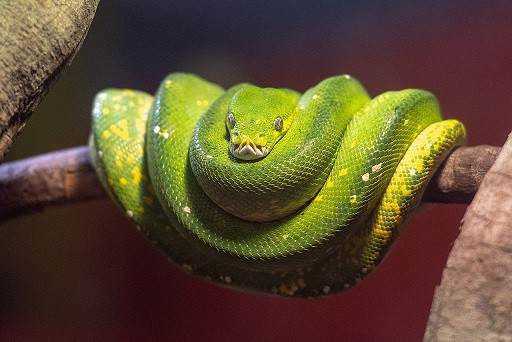
The green tree python is a species of northern Australia, New Guinea, and eastern Indonesia, which holds a couple of records. Firstly, it’s probably the most exclusively tree-dwelling python in the world. Secondly, it’s an extremely popular snake in captivity, with endless online forum posts and even full books discussing its successful husbandry.
Green tree pythons (Morelia viridis) are almost exclusively a forest snake. They’re a lazy ambush species which drape themselves over one branch and remain in place for weeks, ignoring the hustle and bustle of the forest surrounding them. This extreme laziness is one reason why they’re so popular in captivity. In a terrarium, they simply coil up and rest their head in the centre of their looped coils, and it’s no different in a Queensland rainforest.
After sniffing out its prey (which is mostly mammals), the green tree python fastens its prehensile tail even tighter than usual, before lowering its taut upper body towards the ground. When the prey enters striking distance, typically less than one metre away, they make a sudden lunging grab, and apply all their constricting might.
Originally, green tree pythons were placed in the unique genus of Chondropython, until genetic analysis revealed them to belong to the wider Australia genus of Morelia, also containing the carpet python. However, they’re still commonly nicknamed “chondro” in reptile trading circles.
| 2 | Shocking colour transformation |
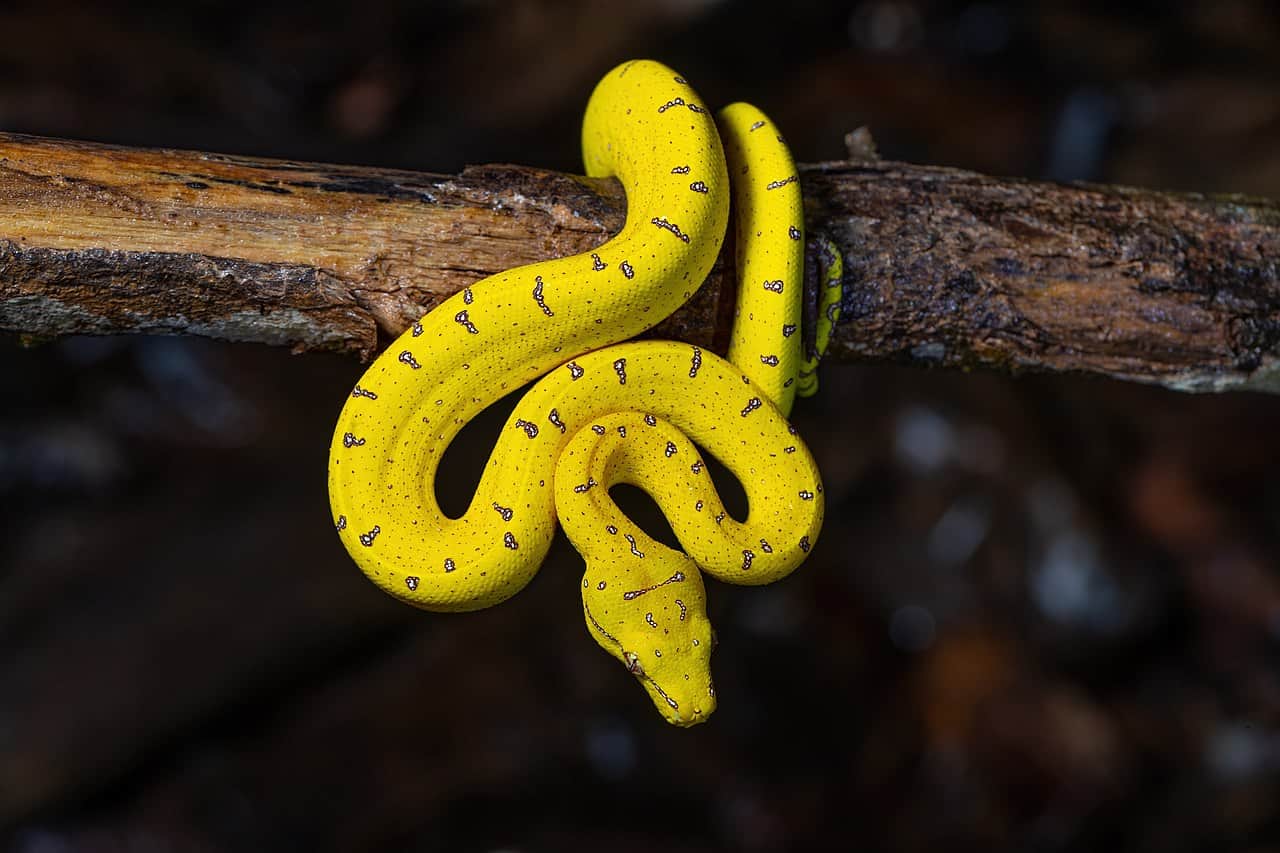
Greenness is the one area where Morelia viridis owns almost all other snakes, but as youths they’re a wild contrast: lemon yellow overlaid with thin, broken stripes. This lasts for an average of 1 year, until a shocking transformation begins. This metamorphosis is one reason why green tree pythons are so popular in captivity. It begins with a few green speckles, with the yellow as dense as ever.
Then, in as little as 8-10 days, the green tree python can metamorphize into the fully-fledged greenness of adulthood, without even shedding its skin. Rather than age, length is the most consistent determiner: 55cm is when the green takeover begins in earnest. If you’re anticipating the change in your own pet, be sure to keep a tape measure handy.
This yellow colour still isn’t understood. Green has obvious camouflage benefits, but yellow would only make sense if they fell into a giant pit of bananas. A few subpopulations even begin life as a brick red. These are found on Biak Island and the Baliem valley of Papua (Indonesia), and in Papua New Guinea’s Sepik basin. These take longer to reach the green of adulthood, as they have to pass through the yellow phase first; there’s extra hoops to jump through to become fully fledged. This red hatchling morph has never been spotted in Australia.
| 3 | A medium length python |
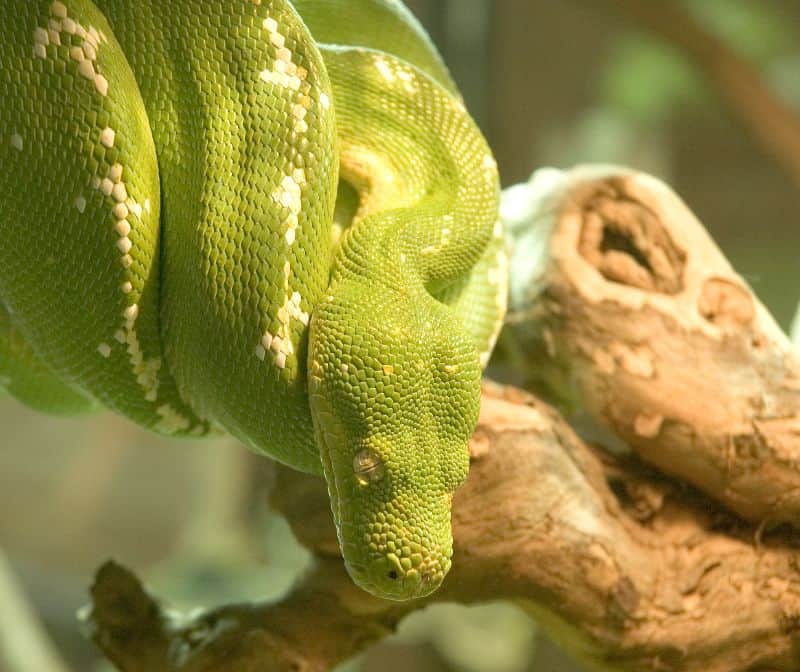
The green tree python’s lifestyle also flips wildly with its colour transformation. Yellow Morelia viridis stick to the ground, patrolling forest outskirts, but when they finally ascend to green greatness, they retreat to rainforest interiors and become branch dwellers for the rest of their lives. Likewise, newborn yellow snakes can hunt during day or night. With the wave of green comes a sudden fear of the sun. The green tree python becomes nocturnal at 1 year old, hunting mostly at night.
Green tree pythons are broken down into subspecies, with all of mainland Australia hosting its own – Morelli viridis shireenae. The main difference is having white spots dotted over the green, compared to the New Guinea and Indonesian versions which are less consistently dotted.
This is a moderate length python, exceeding a ball python but failing to match its carpet python relative. Females can push to 2 metres, while 1.5-1.8 metres is the standard. Males are slightly shorter. Green tree pythons have a tail making up 14% of their total body length.
| 4 | Diet: various mammal species |
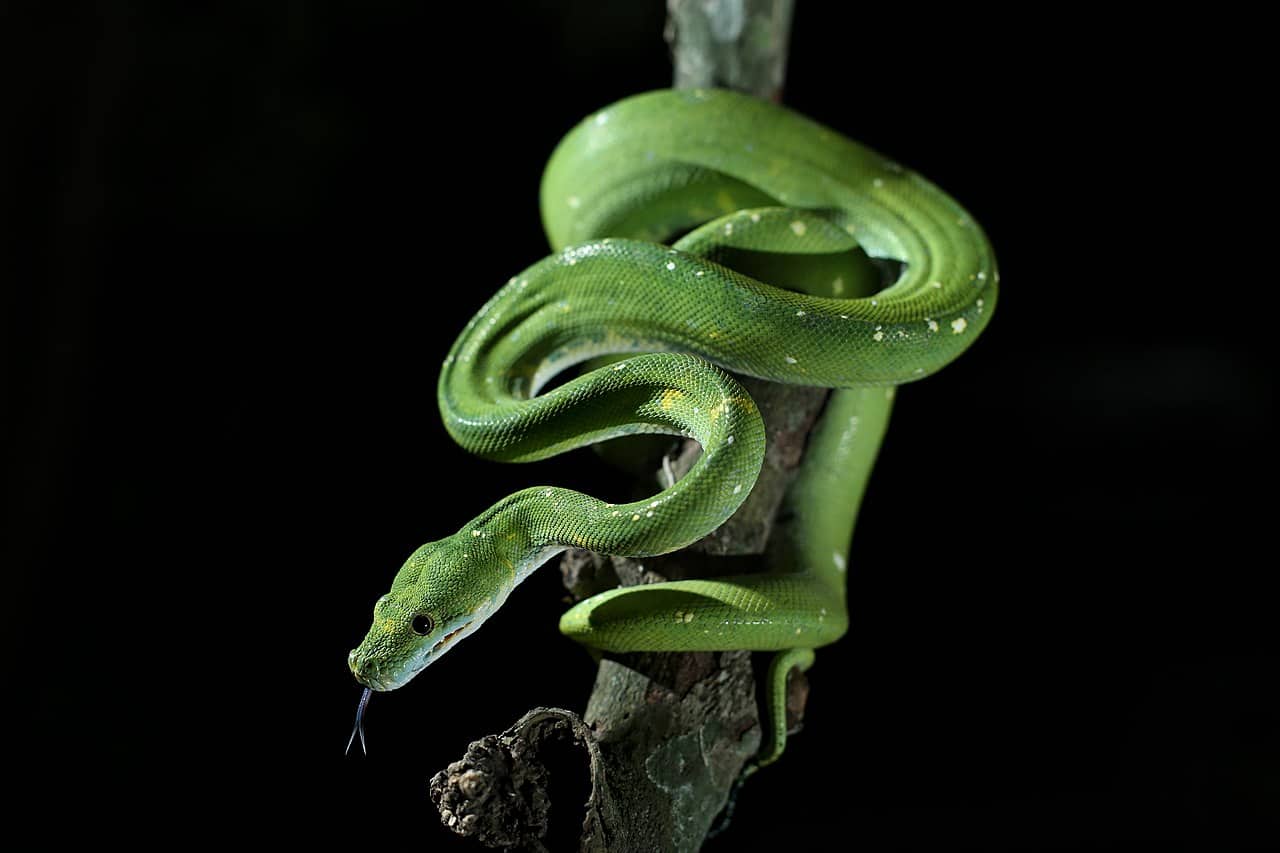
Green tree pythons are mostly a mammal eater. They begin life feeding on smaller reptiles such as closed-litter rainbow-skinks (native to Queensland). As they grow, they gain the ability to gape their mouths extremely wide, and the possibilities become boundless, or less boundless than before at least.
Green tree pythons are particularly fond of Melomys capensis, a rat which is exclusive to Queensland’s Cape York peninsula, and the cape york rat, which is more widespread, also inhabiting New Guinea and Indonesia. There’s something of a debate over whether they eat birds. Karl Switak analysed prey items from over 1000 green tree pythons and didn’t find birds once, but a 2006 study found feathers inside their stomach, species unidentified.
In rainforests, birds mostly flock in the upper canopies, so it’s only green pythons who dare to rest on the highest branches that have access to this tasty treat. It’s possible that the first study only grabbed the green tree pythons lower down, being far simpler to access. Either way, mammals are their main prey.
| 5 | Loves forest and only forest |
A 1999-2005 study from Iron Range National Park in northern Australia found that smaller green tree pythons rested closer to the ground, but still averaged at 10 metres in the air. The largest Morelia viridis ascended to 25 metres above ground level with ease. One green tree python was eaten by a mangrove goanna, with the tracking transmitter still beeping and sending signals from inside the goanna’s stomach.
Another study scoured various locations in the Cape York peninsula. They found 301 green tree pythons, but none in grassland, heathland, swampland, or even woodlands. Dense rainforests were order of the day, the favourite being notophyll vine forests, which are becoming rarer in Queensland. The probability of finding a green tree python in open habitats was approximately zero. This is a true forest species, unlike its relative the carpet python (often found in towns).
Elevation isn’t a problem for green tree pythons, as they appear at up to 2000 metres above sea level in New Guinea. They’re a patient species which can stay on the same branch perch for 14 days.
| 6 | The harsh global trade |
The green tree python ranks in the top 20 snakes for popularity with reptile keepers, possibly higher. So it’s not surprising to hear that traders are scooping them out of the wild in unsustainably high numbers, particularly in Indonesia and Papua New Guinea.
A study entered Indonesia and trudged around speaking to reptile collectors, traders, middlemen and farm owners alike. The team encountered 4221 illegally sourced wild green tree pythons in their travels. By extrapolating monthly collection estimates, they reached a figure of 5331 illegal wild captures per year. They calculated that 80% of green tree pythons leaving Indonesia were wild caught, rather than bred in captivity.
Breeding farms are legal, but many use snake laundering; they capture wild green tree pythons, and keep them at their facilities for a period of time, mingling them with reared snakes so that the authorities can no longer tell the difference. It’s believed that breeding farms are economically inefficient for this species compared to others. One idea proposed is an egg shell token, to prove that farms have genuinely reared the snakes from birth.
| 7 | Many die in captivity |
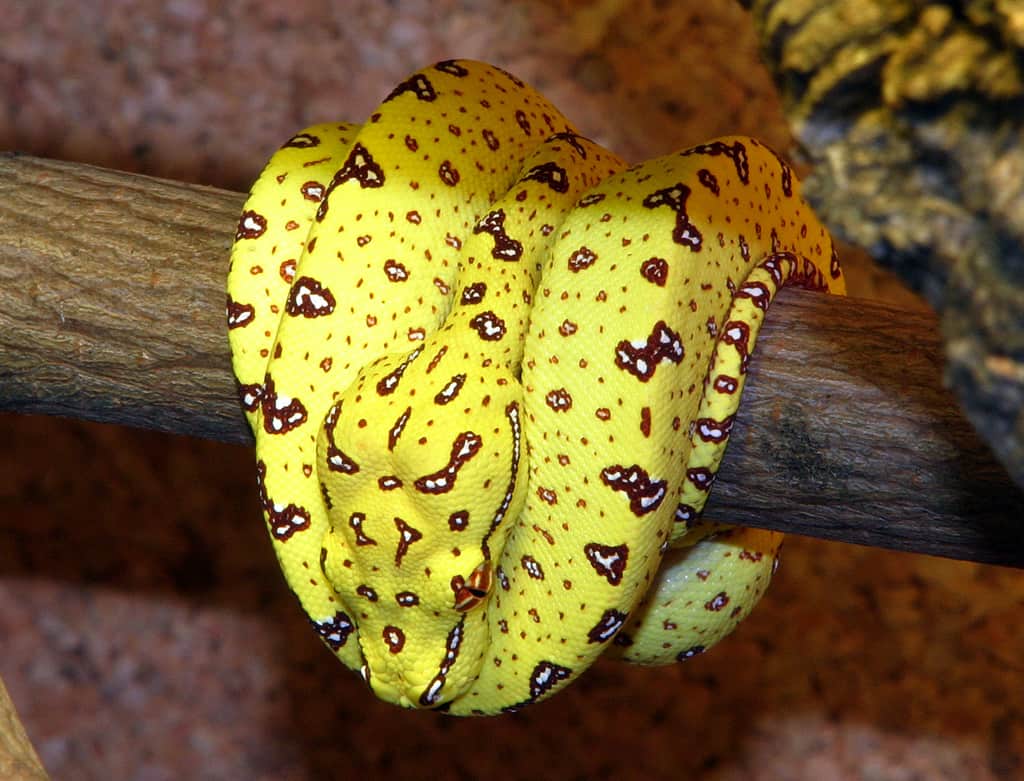
The wild trade is perilous itself, as 40-50% of captive green tree pythons are estimated to die in crates before they reach the market. Corn snakes would be a different story, as they’re so hardy and adaptable, but Morellia viridis is an inflexible rainforest dweller. It’s a painful death caused by parasites and stress, with some bearing scars from the harsh capture operation.
The study above found that 80% of illegally caught green tree pythons were malnourished. In some locations, it was estimated that 50% of green tree pythons die before they even reach Jakarta, which is the main global export hub that smaller suppliers feed into. This is why overseas fans of green tree pythons always take special care to find a trustworthy supplier.
Green tree pythons aren’t at imminent risk of extinction, but certain island populations are being depleted, chief among them Biak Island of Indonesia. This is the land of the red hatchling morph, making it particularly economically attractive for snake catchers. In the same study, the amount of green tree pythons caught on Biak Island decreased significantly from 2009 to 2011. It’s possible that the rampant illegal trade will cause regional extinctions, including of the most special morphs.
| 8 | Calm or vicious? People disagree |
Opinions vary on the exact personality of a green tree python in captivity. Some compare them appreciatively to a fluffy bunny, while others refer to them as the demon spawn of hell. Green tree pythons are typically calm if left alone, but rapidly turn aggressive if handled roughly, perhaps if draped around the keeper’s neck for a photo opportunity. Given that the cage must be cleaned and the snake fed, some experts believe that getting bitten is simply inevitable. Apparently the term that best describes them is “snappy”.
Green tree pythons feed happily on the usual diet of mice while in captivity, but some experts warn against flinging them rats, mainly because they enjoy the taste so much that they become obese! They can apparently guzzle up rats well beyond their natural calorie requirements.
Green tree pythons have a fragile spine as well, which is easy to damage during handling. As babies, even careful handling can cause spinal damage which only becomes apparent later in life, so be very careful. Accidents have happened when keepers forcibly remove juveniles from their perches.
| 9 | The Brazilian clone |
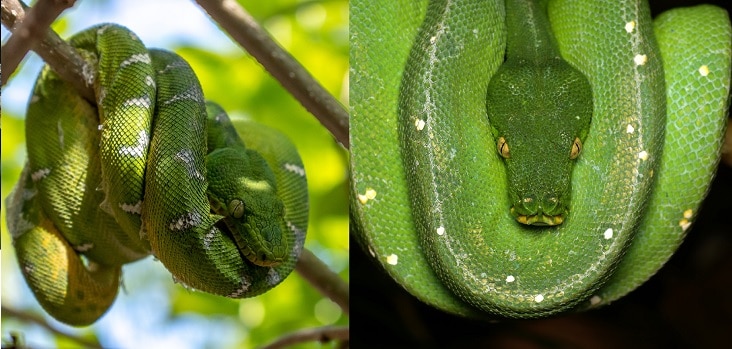
The green tree python is one of the most extreme case of convergent evolution in the world. This is when two creatures have little to no relation, yet have evolved near identical characteristics due to living in near identical circumstances. The clone of Morellia viridis is the emerald tree boa, of the Amazon rainforest over 10,000 miles away.
Just look at the picture above – they’re both ultra-green, ambush-happy, constricting machines with hungry, crocodilian faces. They both live in forests exclusively, resting on tree branches all day before swinging down suddenly to ambush mammals. They’re so freakishly similar that they undergo the same change from yellow or red to green as adults, despite diverging tens of millions of years ago.
The biggest difference of these lookalike snakes is the heat-sensing IR pits. Emerald tree boas have them on both the upper and lower lips, while green tree pythons have just the upper pits. The consensus among snake keepers is apparently that emerald tree boas look more cunning and vicious, while green tree pythons are cuter (you can decide).
| 10 | Split into two species |
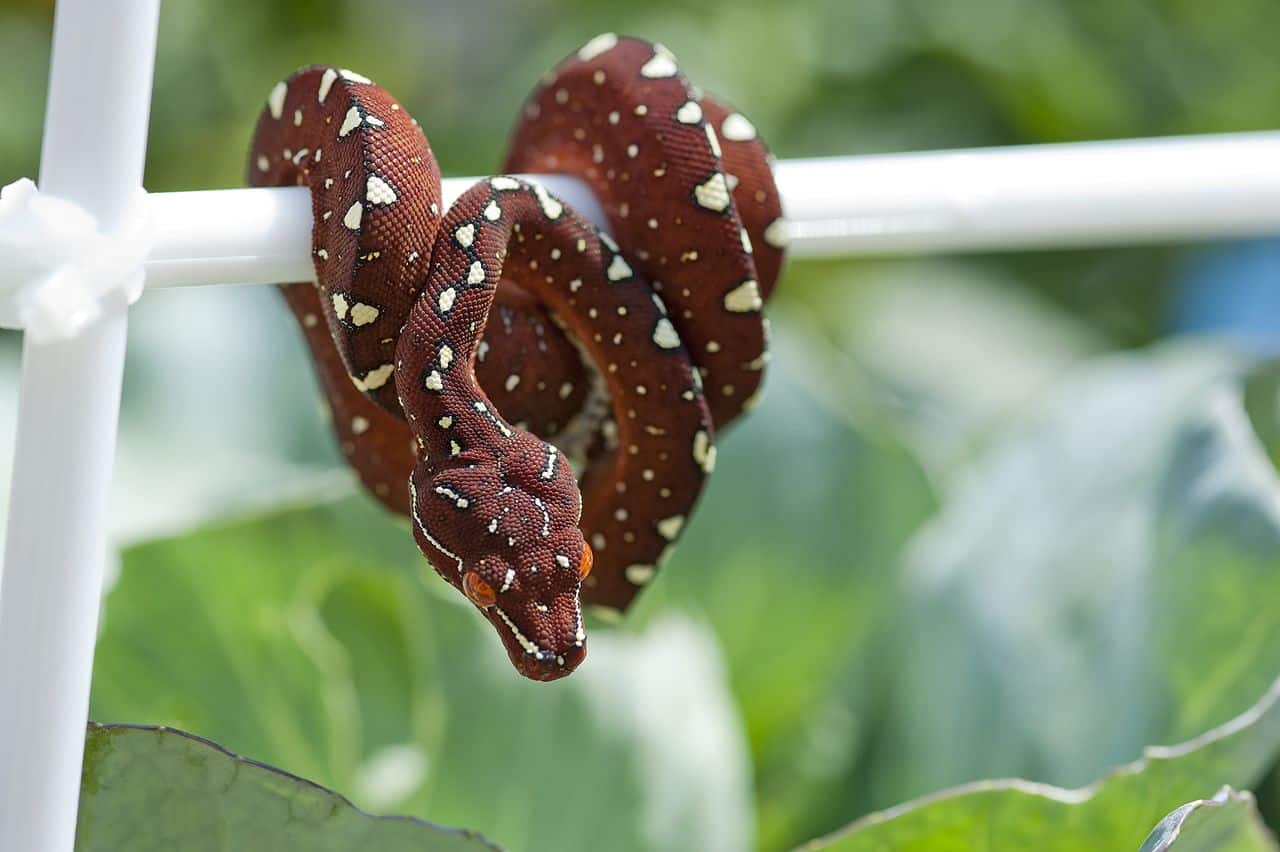
In 2009, a large chunk broke off the empire and drifted away, even though it was actually always separate and geneticists hadn’t realised it yet. This was a new species altogether – the northern green tree python (Morelia azurea). This lives in northern New Guinea, and is divided from the main species by the island’s steep central mountains, which run as a spine from east to west. The green colours and primitive face are virtually identical, with only minor pattern differences as clues. But it’s believed that Morelia azurea and the main green tree python diverged 5.8 to 3.5 million years ago.
Many reptile keepers will have cared for this northern species in decades gone by without realising it. Rather than white spots down its spine, the northern green tree python has a continuous blue line. Their eyes have banded patterns as juveniles, and they have a more aggressive temperament. Subtle scale differences also supported the separation.
Later, things got even more complicated, as Morelia azurea was broken down into three further subspecies within New Guinea. The famed green pythons of Biak Island, the pythons which begin life as brick red, became their own subspecies, simply called Morelia azurea azurea. This was found to have the most aggressive personality of all.
